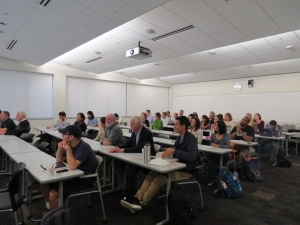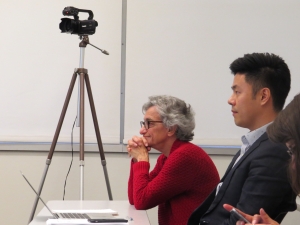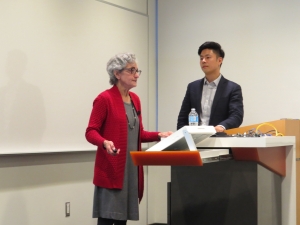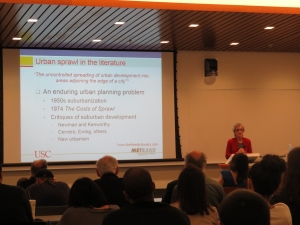(see more photos and Dr. Giuliano’s slides below)
Dr. Genevieve Giuliano, this year’s Perloff Speaker, gave a lecture titled, “Spatial Dynamics of the Logistics Industry in California Metropolitan Areas.” This lecture was also part of the Urban Goods Movement Lecture Series, organized by the Lewis Center in partnership with the Community Scholars Program and Center, the UCLA Department of Urban Planning, Labor Occupational Safety & Health Program (LOSH), Downtown Labor Center, Center for Occupational and Environmental Health (COEH), Institute of Transportation Studies, and Institute for Research on Labor and Employment (IRLE).
Although dealing with urban sprawl has been an enduring urban planning problem, much less attention has been paid to “logistics sprawl,” which is the relocation and deconcentration of logistics facilities such as warehouses outside city centers. The increased distance of the warehouse and distribution (W&D) sector from markets has a negative impact on quality of urban life, causing increased GHG emissions, air pollution, and noise. Some factors that may have changed location patterns include reduced transport costs, a shift from “push” to “pull” logistics that favor reduced dwell time, and favorable land zoning policies.
There have been thousands of studies on passenger travel, but we have almost no understanding of freight movement. For example, while mode choice for personal travel is very well understood and modeled by transportation planners, something as basic as mode choice for freight has remained relatively unexamined. The two types of travel differ greatly: freight travels only by demand, not discretion; freight is efficient and moved by system mangers who are always optimizing the process; freight also goes everywhere and comes from everywhere, traveling from very long distances. Finding a local solution for, say, maintaining a year-round supply of seasonal fruits, can be problematic. Giuliano and USC PhD student Sanggyun Kang found in their literature review that there is little consistency in decentralization across regions from Los Angeles to Amsterdam to Japan.
In a study of four metropolitan regions, Los Angeles, San Francisco, Sacramento, and San Diego, Giuliano finds that employment in W&D is decentralizing in all four areas, and that warehousing and distribution establishments are decentralizing in LA. Economic growth in W&D has been much bigger than growth in other sectors. In Los Angeles, for example, the number of W&D establishments increased by 30% between 2003 and 2013 and employment went up by 40%. Until now, logistics sprawl was only anecdotally observed, so it is exciting to see Giuliano begin to rigorously dissect the available data. She has laid a strong foundation for continuing research and exploration of the policy implications.
View Dr. Giuliano’s slides here.



